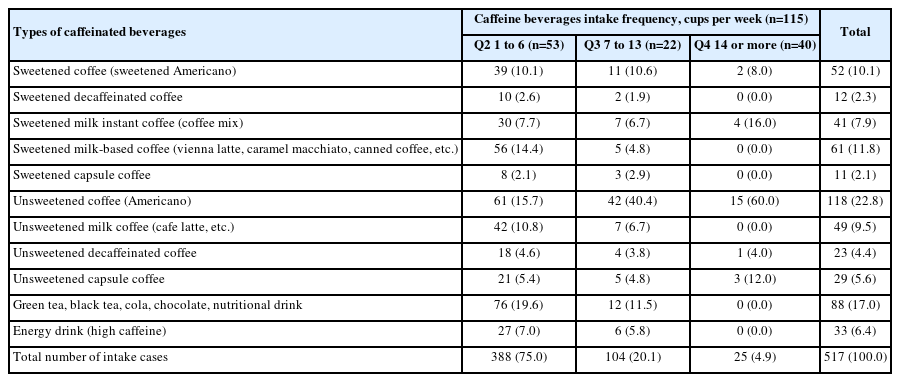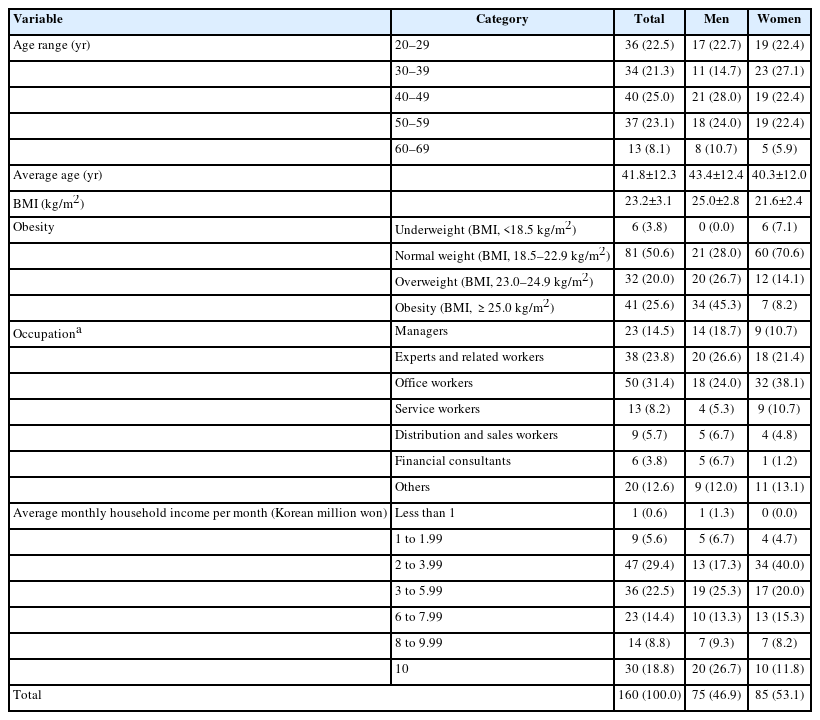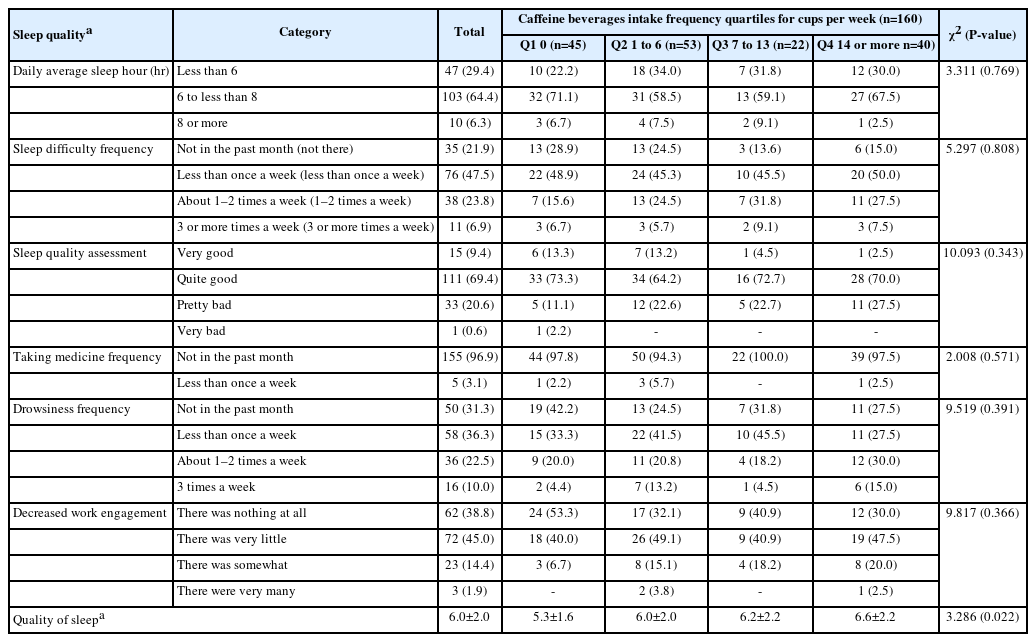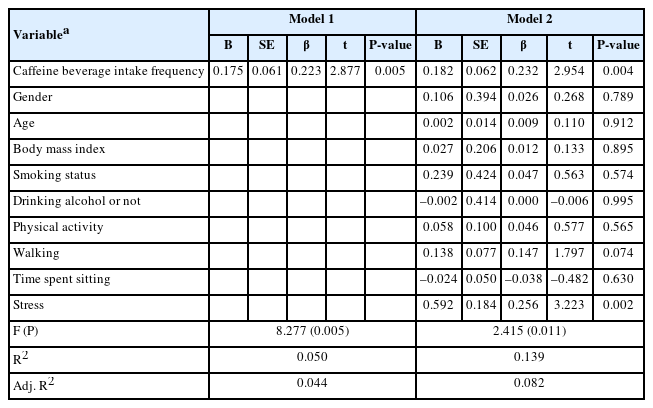Association between Caffeinated Beverages Consumption and Sleep Quality of Urban Workers
Article information
Abstract
Background
The stimulatory effects of caffeine contribute to poor sleep quality. However, the relationship between caffeinated beverages and sleep quality, considering frequency or types of caffeinated beverages, were not extensively studied.
Methods
Data were collected from 160 urban workers (75 men [46.9%] aged 20–69 years; with an average age of 41.8±12.3 years) using a structured, self-administered online questionnaire. Sleep quality, time, satisfaction; types and frequency of caffeinated beverages (number of cups per week; Q1: 0 cup, Q4: 14 or more cups per week), demographics, and health behaviors were asked. Sleep quality were evaluated using the Korean version of the Pittsburgh Sleep Quality Index (PSQI-K). Multiple regression analysis was conducted on the association between the frequency of caffeinated beverages consumption and sleep quality.
Results
The most frequently consumed beverages were unsweetened coffee (22.8%) and the most common time for caffeine was between 12 pm to 5 pm (58.2%). The average sleep quality score based on the PSQI-K was 6.0±2.0 overall, 5.3±1.6 in Q1, and 6.6±2.2 in Q4 (frequent caffeinated beverage drinkers), indicating poorer sleep quality in Q4 (P=0.022). In Q1, 13.3% rated their sleep quality as ‘very good,’ while in Q4, only 2.5% gave the same rating. Poor sleep quality was significantly associated with the frequency of caffeinated beverages per week (β=0.232, P=0.004) and self-reported stress level (β=0.256, P=0.002).
Conclusions
Frequent consumption of caffeinated beverages appears to be associated with poor sleep quality among urban workers. While reducing caffeine intake may contribute to improvements in sleep quality as a health promoting behavior, this hypothesis requires validation through future studies employing personalized intervention approaches.
INTRODUCTION
Irregular sleep habits can result in fatigue, anxiety, stress, anger, and depression, and may lead to sleep disorders such as hypersomnia or insomnia [1]. Sleep quality refers to the total sleep duration, time required to fall asleep, sleep efficiency by calculating the proportion of the time spent actually sleeping after going to bed, hypnagogic latency, the time it takes to fall asleep, mid-sleep awakening, enuresis during sleep, and the subjective evaluation of fatigue, mood, and overall sleep satisfaction [2]. Poor sleep quality increases the risk of cognitive dysfunction, including impairments in memory and concentration, which can reduce both productivity and quality of life [3].
According to data from the Korean National Health Insurance Corporation, the number of patients visiting medical institutions due to sleep disorders rapidly increases, reaching 910,606 in 2018 and 1,097,282 in 2021. Medical expenses also continue to increase, by approximately from 119.9 billion won in 2017 to 252.8 billion won in 2021, more than doubling in 5 years [4].
Sleep disorders arise from a combination of various factors including lighting, temperature, humidity, sleep environment such as bedding, physical activity, eating habits, stress, presence of disease, pain, seasonal changes, and age. Among these factors, the consumption of caffeinated beverages is particularly notable as a dietary habit that adversely affects sleep quality.
Coffee consumption in South Korea is reported to be over 400 cups per capita annually [5]. Changes in lifestyle and cultural preferences have led to a rise in habitual coffee consumption and the intake of other caffeinated beverages. According to data from the Korea Customs Service [6], the annual coffee import amount is 200,000 tons in 2022, an increase of 9.5% compared to the previous year, reaching the highest level ever. Similarly, the number of coffee and beverage establishments has doubled, increasing from 49,000 in 2018 to 99,000 in 2022 [7]. Additionally, the consumption of high-caffeine beverages, commonly referred to as ‘energy drinks’ has risen due to their rapid stimulating effects compared to coffee.
Caffeine, the primary active ingredient in coffee, stimulates the central nervous system and can produce adverse effects when consumed in excess. Accordingly, the Ministry of Food and Drug Safety [8] recommends that adults limit their caffeine intake to less than 400 mg per day.
Previous studies have demonstrated that caffeine’s stimulating effects can negatively impact sleep quality [9]. For example, a study investigating the relationship between anxiety, depression, and sleep quality in nursing students reported that 15.6% of participants experienced insomnia as a side effect of consuming high-caffeine beverages [10]. Among shift workers, sleep quality was found to be better in individuals consuming less than one cup of caffeinated beverages per day compared to those consuming two to three cups daily [11].
However, research exploring the relationship between sleep quality and specific drinking patterns—such as the types of caffeinated beverages consumed, the frequency of consumption, and the usual time of day for caffeine intake, adjusted for behavioral factors—remains limited.
In this study, we examined the relationship between the sociodemographic and health-related characteristics of urban workers and their caffeinated beverage consumption patterns, including beverage types and frequencies, and their sleep quality.
METHODS
Participants
This study used the G*POWER program on subjects to analyze the relationship between urban workers’ caffeinated beverage intake and sleep quality. The relationship between independent variables and sleep quality was analyzed with a medium effect size (0.15). The sample size was calculated with a power of 95% and a significance level of 0.05, and 146 participants were required. The survey was conducted on a total of 198 respondents in August 2023, assuming that 26% of participants might drop out due to missing data.
A final 160 respondents were selected after excluding 38 respondents with missing values in the main variables of interest. Participants were asked to voluntarily join through the URL and QR code, which contained the purpose of the study and research consent form. Consent to participate in the study was obtained by selecting the consent button through an online survey.
To protect the rights and interests of the subjects of this study, approval was obtained according to the review procedure from the Institutional Review Board of Severance Hospital, Yonsei University Health System, on August 8, 2023 (4-2023-0787).
Data collection
The evaluation items for this study included 14 questions on sleep quality, six questions on caffeine beverage consumption caffeine awareness, and sociodemographic characteristics, and 29 health-related characteristic survey questions, consisting of a total of 49 questions.
Sleep quality evaluation tool
For sleep quality, the 15-item ‘Korean Version of the Pittsburgh Sleep Quality Index (PSQI-K),’ which is a validated Korean translation of the PSQI, was used. This includes one question on average daily sleep duration, one question on sleep latency, eight questions on sleep disturbance, one question on sleep efficiency, one question on subjective sleep quality, one question on taking sleeping pills, one question on drowsiness during social activities, and one question on work concentration. The subjective sleep quality was evaluated for each question: ‘very good’ 0 points, ‘fairly good’ 1 point, ‘quite bad’ 2 points, ‘very bad’ 3 points, and a total score of 21. For the evaluation of sleep problems, ‘no sleep problem for a month (none)’ 0 points, ‘less than once a week’ 1 point, ‘1–2 times a week’ 2 points, ‘3 or more times a week,’ ‘I couldn’t fall asleep within 30 minutes of going to bed for a month’ with a score of 3, a higher score means poorer sleep quality [12].
Caffeine beverage intake frequency and caffeine awareness survey
Caffeine intake frequency was collected as number of cups per week and divided into four groups, 0 drinks per week Q1, 1–6 drinks Q2, 7–13 drinks Q3, and 14 or more drinks per week Q4. 11 types of caffeinated beverages data were collected including sweetened coffee, sweetened decaffeinated coffee, unsweetened coffee, energy drink (Table 1). Usual times of caffeinated beverages drinking, reasons for consuming caffeinated beverages, perception on caffeine related to sleep quality, and intention to reduce or quit caffeinated drinks to improve sleep quality were also investigated.
Survey of sociodemographic and health-related characteristics
The survey was conducted by classifying the participants’ gender and age, type of occupation, whether they were full-time or not, and monthly household income. By entering the height and weight as health-related characteristics of the survey participant, the body mass index (BMI) of the participants was calculated. According to the standards of the Korean Society for the Study of Obesity (2022), less than 18.5 kg/m2 is considered underweight, 18.5 to 22.9 kg/m2 is classified as normal, 23.0 to 24.9 kg/m2 as overweight, and over 25 kg/m2 as obese [13].
The health-related characteristics of the survey participants were investigated by dividing them into former smokers, current smokers, and non-smokers. Alcohol drinking was examined by dividing the number of days on which alcohol was consumed over the past 30 days and the average daily amount. In the past 7 days, the number of days performing physical activity of moderate or higher intensity that resulted in sweating, the number of days walking more than 10 minutes per week, and the average sedentary time per day were measured in minute. For stress levels, participants were asked to select one of the following options: “I feel very much,” “I feel a lot,” “I feel a little,” “I do not feel very much,” or “I do not feel at all.”
Statistical analysis
The findings obtained in this study were statistically analyzed using the IBM SPSS/WIN 21 program (IBM Corp.) and statistical significance was based on a two-sided test with a significance level of 0.05. The relationship between sleep quality, sociodemographic characteristics, and health-related characteristics was analyzed in the four groups of urban workers who consumed caffeinated beverages. Univariate analysis was performed using descriptive statistics, t-test, and ANOVA. If there was a significant difference after analysis of variance, post-hoc analysis was performed using the Tukey test.
Multiple regression analysis was performed as a multivariate analysis to determine the relationship between urban workers’ weekly caffeine intake frequency and sleep quality. The multiple regression model was adjusted for age, gender, BMI, physical activity, walking time, sedentary time, and stress.
RESULTS
The participants in this study were 160 adults, including 75 men (46.9%) and 85 women (53.1%). Age distribution was as follows: 22.5% (n=36) were aged 20–29 years, 21.3% were aged 30–39 years, 25.0% were aged 40–49 years, 23.1% were aged 50–59 years, and 8.1% were aged 60–69 years. The average age was 41.8±12.3 years, with men having a higher average age of 43.4±12.4 years (ranging from 20 to 69 years) and women at 40.3±12.0 years. Regarding occupation, participants were categorized as follows: managers (14.5%, n=23), experts and related workers (23.8%), office workers (31.4%), service workers (8.2%), distribution and sales workers (5.7%), financial consultants (3.8%), and others (12.6%), with office workers being the most prevalent. The average BMI was 23.2±3.1 kg/m2. Of the participants, 20.0% (n=32) were overweight, and 25.6% (n=41) were classified as obese (Table 2).
Table 1 presents the results of the division of caffeinated beverage consumption by type from multiple responses, categorized into three groups based on the number of cups consumed per week, among participants who drank more than one cup of caffeinated beverages per day on average. The most frequently consumed beverage was unsweetened coffee (‘Americano’) at 22.8%, followed by green tea, black tea, cola, chocolate, and nutritional drink at 17.0%, and sweetened milk-based coffee (such as vienna latte, caramel macchiato, canned coffee, etc.) at 11.8%.
In the group that consumed 1–6 cups of caffeinated beverages per week, 19.6% consumed green tea and similar beverages, 15.7% consumed unsweetened coffee, and 14.4% consumed sweetened milk-based coffee. In the group consuming 7–13 cups per week, unsweetened coffee was the most common beverage at 40.4%. Finally, 4.9% of intake cases were allocated in the ‘more than 14 cups of caffeinated beverages a week’ group, with unsweetened coffee being the most frequently consumed beverage at 60.0% (Table 1).
Caffeine beverage intake frequency and sleep quality are presented in Table 3. The majority of participants (64.4%) reported an average sleep duration of ‘6 hours or more, but less than 8 hours,’ followed by ‘less than 6 hours’ at 29.4%, and ‘more than 8 hours’ at 6.3%.
In the analysis of sleep status, which included average daily sleep duration, subjective sleep quality assessment, frequency of drowsiness, and decreased work engagement, no significant correlation was found between caffeine intake frequency and sleep quality. However, in Q4 (frequent coffee drinkers), 2.5% rated their sleep quality as ‘very good,’ and 27.5% as ‘pretty bad.’ In contrast, in Q1 (0 cups per week), 13.3% rated their sleep quality as ‘very good,’ and only 11.1% as ‘pretty bad.’ Particularly, the average sleep quality score in Q1 was 5.3±1.6, while in Q4, the sleep quality was poor as 6.6±2.2 (P=0.022).
Multiple regression analysis was performed to determine the influence of caffeine consumption on sleep quality (Table 4). Hierarchical regression analysis was performed to determine the influence of caffeine consumption frequency on sleep quality. Model 1 included beverage frequency, which gave an explanatory power of 4.4%, and showed that office workers with high caffeine consumption frequency had significantly lower sleep quality than urban workers with low frequency (β=0.223, P=0.005).
Model 2 included caffeine consumption frequency, gender, age, BMI, smoking status, drinking status, days of physical activity during the week, days of walking during the week, average sitting time per day, and stress. As a result of the multicollinearity test, the Variance Inflation Factor value was greater than 10, indicating that all variables had no multicollinearity problems. Model 2 had an explanatory power of 8.2%, and showed that sleep quality was lower when beverage frequency was higher (β=0.232, P=0.004) and stress was higher (β=0.256, P=0.002).
The reasons for consuming caffeinated beverages, categorized by quartiles of caffeine beverage intake frequency measured in cups per week, are described in Appendix Table 1. “It’s just a habit” was the most common reason (47.5%), followed by “I drink it to change my mood” (26.9%), “I drink it to avoid sleepiness” (18.8%), and other reasons (6.9%). However, there were no statistically significant differences among the quartiles. The most common time for caffeine was between noon to 5 pm (58.2%).
The survey results on the intention to reduce or quit caffeine beverage intake to improve sleep quality (Appendix Table 2) included participants’ awareness that consuming caffeinated beverages affects sleep quality. A total of 141 participants (88.1%) responded with “I know.” Regarding their intention to reduce or quit caffeinated beverage intake, 19.4% had ‘no intention at all,’ 40.0% said “it is difficult right now, but I will think about it,” 26.9% said “I will try to reduce it gradually,” and 13.8% indicated “I will take action immediately to improve the quality of my sleep.” A total of 129 participants (80.6%) indicated a willingness to reduce their caffeine intake to improve sleep quality.
For those who responded that they had ‘no intention at all’ to quit caffeinated beverages to improve sleep quality, 74.2% said, “I sleep well regardless of caffeine intake” while 16.1% stated, “Drinking caffeinated beverages has become a habit and is hard to quit.”
DISCUSSION
This study analyzed the relationship between the frequency of caffeinated beverage intake and sleep quality through an online survey targeting adult urban workers. Results indicate that frequent consumption of caffeinated beverages was significantly associated with poor sleep quality, even after adjusting for related variables.
The recommended daily caffeine intake for adults is less than 400 mg. According to the Ministry of Food and Drug Safety, caffeine concentrations in common beverages include 62.7 mg in unsweetened coffee, 25.3 mg in green or black tea, 34.8 mg in cola, 37.5 mg in tonic water, 41.6 mg in unsweetened coffee milk, 67.4 mg in sweetened coffee (e.g., mixed or canned coffee), and 58.1 mg in high-caffeine beverages [14]. Exceeding the recommended intake is a risk when consuming multiple servings of these beverages. While caffeine has been reported to have protective effects, such as reducing the risk of hypertension, it has also been linked to increased cardiovascular disease mortality, highlighting conflicting conclusions regarding its health outcomes [15]. Therefore, it is needed to explore the long-term health effects of consuming various kinds of caffeinated beverages.
This study focused on the negative impact of caffeine on sleep quality, which is as crucial as sleep duration. Sleep quality plays a significant role in improving workers’ productivity and achieving a better work-life balance [14]. Previous research has indicated that individuals sleeping less than 9 hours are 1.3 times more likely to report good subjective health [16]. In this study, we also reported the association between frequent coffee drinking and poor sleep quality.
There was no significant correlation between the frequency of caffeine consumption and indicators such as daily sleep duration, frequency of sleep difficulties, or overall sleep quality assessment. However, in the subjective sleep quality assessment, 2.5% of Q4 (respondents with a high frequency of consumption) answered that their sleep quality was very good, while 13.3% of Q1 responded as same. In addition, 27.5% of Q4 and 11.1% of Q1 responded that their sleep quality was ‘pretty bad.’ Looking at these results, it is thought that there may be a certain tendency between caffeinated beverages and sleep quality, although it was not significant. The number of subjects in this survey may not have been sufficient to test the difference in these sub-domain items rather than the overall sleep quality.
Also, although not reported in this paper, among the sleep quality sub-items results of the authors, in the case of ‘could not fall asleep within 30 minutes after going to bed,’ 20.0% of the Q4 responded that they had difficulty more than three times a week, while it was 11.1% in Q1 (P=0.035; data not shown). Therefore, it is thought that there was a significant correlation as there were differences in some of these sleep quality sub-items, with the total score average was poorer in Q4.
Despite the recognized impact of caffeine on sleep, changing caffeine consumption behavior appears to be challenging. In this study, 80.6% of respondents expressed an intention to reduce or stop consuming caffeinated beverages to improve sleep quality, while 19.4% reported no such intention. The most cited reasons for consuming caffeinated beverages was “It’s just a habit” (47.5%). Culturally ingrained practices, such as drinking coffee after meals and the widespread use of coffee coupons as gifts, contribute to the difficulty in changing these behaviors [17].
This study has several limitations. First, the data were obtained through convenience sampling and may not be representative of all urban workers. However, the sample size was sufficient to achieve the statistical power required for the analysis, ensuring the reliability of the findings. Second, this was a cross-sectional study that analyzed the relationship between caffeine intake and sleep quality, making it impossible to establish causality.
Third, a dietary intake survey was not conducted to accurately quantify caffeine content in each beverage. Although weekly caffeine intake frequency was assessed, the actual caffeine content of beverages was not measured. Additionally, highly caffeinated and high-energy drinks were not separately classified. Decaffeinated beverages were included in the analysis, as they still contain small amounts of caffeine (2–4 mg), which may cause insomnia in caffeine-sensitive individuals [18]. Future studies should aim to quantify caffeine levels in beverages more precisely.
Fourth, sleep quality was assessed using the PSQI-K, a validated tool; however, the subjectivity of self-reported data cannot be ruled out. Objective methods, such as polysomnography, could not be employed in this study. Polysomnography is necessary for future research to ensure the objectivity of measurements, including electrocardiogram, electromyogram, oxygen saturation, sleep apnea, and brain wave activity during sleep [19]. Advances in digital healthcare technology may offer promising alternatives for measuring sleep quality with objective data through sensors mounted on mattresses and pillows at home for monitoring with wearable devices such as a smartwatch. Analytic methods were developed for the sleep stages, sleep duration, and sleep efficiency of deep sleep, rapid eye movement sleep, and light sleep by measuring heart rate [10]. This can be used as a tool to reduce individual subjective judgments and errors and evaluate sleep quality with more objective data [20].
Palpitations occur in people who are genetically slow to metabolize caffeine. It is known that the half-life time for decomposing and excreting caffeine, that is, the sensitivity and reaction phenomenon, are different for each individual. A study suggested a possibility of myocardial infarction among the slow metabolizers of coffee [21]. Personalized assessments of caffeine tolerance, including recognition of individual variations in caffeine half-life, time to decompose and excrete caffeine components, could help improve sleep quality.
Although the relationship between caffeinated beverage consumption and insomnia or sleep quality has been studied among nursing students [10] and shift workers [11], research on the types of caffeinated beverages and consumption behaviors among young to middle-aged urban workers who frequently drink coffee is limited.
In this study, we reported the association between frequent caffeinated beverage and poor sleep quality, measured using the PSQI-K, in urban workers. Additionally, we provided a detailed analysis of caffeine consumption behaviors, including the types of caffeinated beverages consumed and their consumption frequency.
To enhance sleep quality, reducing the frequent intake of caffeinated beverages may serve as an effective component of sleep hygiene strategies. Future research is warranted to explore the impact of various types of caffeinated beverages, incorporating precise quantification and behavioral interventions. “The quality of sleep is the quality of life.” Since sleep quality constitutes a third of our lives, managing caffeinated beverage consumption should be regarded as a health-promoting behavior to prevent insomnia and enhance overall well-being.
Notes
AUTHOR CONTRIBUTIONS
Heejin KIMM had full access to all of the data in the study and takes responsibility for the integrity of the data and the accuracy of the data analysis. All reviewed this manuscript and agreed to individual contributions.
Conceptualization: BIH, JYL, and HK. Data curation: BIH, HJL, and RH. Formal analysis: BIH, JYL, and RH. Methodology: MR, SHJ, and HK. Supervision: MR, SHJ, and HK. Writing–original draft: BIH, HK. Writing–review & editing: all authors.
CONFLICTS OF INTEREST
No existing or potential conflict of interest relevant to this article was reported.
FUNDING
None.
DATA AVAILABILITY
The data presented in this study are available upon reasonable request from the corresponding author.






